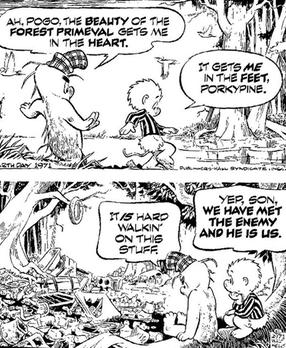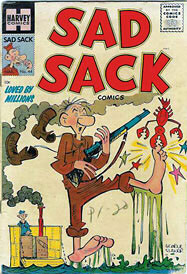
The Katzenjammer Kids is an American comic strip created by Rudolph Dirks in 1897 and later drawn by Harold Knerr for 35 years. It debuted on December 12, 1897, in the American Humorist, the Sunday supplement of William Randolph Hearst's New York Journal. The comic strip was turned into a stage play in 1903. It inspired several animated cartoons and was one of 20 strips included in the Comic Strip Classics series of U.S. commemorative postage stamps.
Overboard is Chip Dunham's daily newspaper comic strip about a shipload of incompetent pirates. It debuted in July 1990 and is distributed by Andrews McMeel Syndication.

Pogo was a daily comic strip that was created by cartoonist Walt Kelly and syndicated to American newspapers from 1948 until 1975. Set in the Okefenokee Swamp in the Southeastern United States, Pogo followed the adventures of its anthropomorphic animal characters, including the title character, an opossum. The strip was written for both children and adults, with layers of social and political satire targeted to the latter. Pogo was distributed by the Post-Hall Syndicate. The strip earned Kelly a Reuben Award in 1951.

The Broons is a comic strip in Scots published in the weekly Scottish newspaper The Sunday Post. It features a Brown family, which lives in a tenement flat at 10 Glebe Street in the fictional Scottish town of Auchentogle or Auchenshoogle.

Nancy is an American comic strip, originally written and drawn by Ernie Bushmiller and distributed by United Feature Syndicate and Andrews McMeel Syndication. Its origins lie in Fritzi Ritz, a strip Bushmiller inherited from its creator Larry Whittington in 1925. After Fritzi's niece Nancy was introduced in 1933, Fritzi Ritz evolved to focus more and more on Nancy instead of Fritzi. The new strip took the old one's daily slot, while Fritzi Ritz continued as a Sunday, with Nancy taking the Sunday slot previously filled by Bushmiller's Phil Fumble strip beginning on October 30, 1938.

Gustave Verbeek was a Dutch-American illustrator and cartoonist, best known for his newspaper cartoons in the early 1900s featuring an inventive use of word play and visual storytelling tricks.

Henry is a comic strip created in 1932 by Carl Thomas Anderson. The title character is a young bald boy who is mostly mute in the comics. Except in a few early episodes, when the comic strip character communicates, he does so largely but not entirely through pantomime. He also spoke in a comic book series of 1946–1961 and in at least one Betty Boop cartoon from 1935 in which Betty Boop has a pet shop and Henry speaks to a dog in the window.

George S. Wunder was an American cartoonist best known for his 26 years illustrating the Terry and the Pirates comic strip.
A gag cartoon is most often a single-panel cartoon, usually including a caption beneath the drawing. In some cases, dialogue may appear in speech balloons, following the common convention of comic strips. A pantomime cartoon carries no caption.
Notable events of 1937 in comics.

Skive is a town in Skive municipality in Region Midtjylland at the base of Salling Peninsula, a part of the larger Jutland peninsula in northwest Denmark. It is the municipality's main town and the site of its municipal council.

Otto Soglow was an American cartoonist best known for his comic strip The Little King.

Sad Sack is an American comic strip and comic book character created by Sgt. George Baker during World War II. Set in the United States Army, Sad Sack depicted an otherwise unnamed, lowly private experiencing some of the absurdities and humiliations of military life. The so-called "unnamed private" was actually Ben Schnall, a true-life private in the US Army during World War II, member of Yank magazine and good curmudgeonly friend of Sgt. George Baker. The title was a euphemistic shortening of the military slang "sad sack of shit", common during World War II. The phrase has come to mean "an inept person" or "inept soldier".
Liō is a daily comic strip created by American artist Mark Tatulli and distributed by Universal Press Syndicate/Universal Uclick/Andrews McMeel Syndication since May 15, 2006. As a pantomime strip, it has an international appeal. In 2008, the strip brought Tatulli a National Cartoonists Society Newspaper Comic Strip Award.

Alfred John Plastino was an American comics artist best known as one of the most prolific Superman artists of the 1950s, along with his DC Comics colleague Wayne Boring. Plastino also worked as a comics writer, editor, letterer, and colorist.

The Kin-der-Kids and Wee Willie Winkie's World were early newspaper comics by painter Lyonel Feininger and published by the Chicago Sunday Tribune during 1906–07.
Hergé, the Belgian comics author best known for The Adventures of Tintin, also created a number of short-lived, lesser-known comic strips.
Frank Thomas (1914–1968) was an American Golden Age cartoonist who worked primarily for Centaur Publications.
Henning Dahl Mikkelsen was a Danish cartoonist, best known for creation of the long running newspaper comic strip Ferd'nand, which he signed as Mik. He was born in Skive, Denmark, and began the pantomime humor strip Ferd'nand in 1936. Because it had no dialogue or captions, it soon was circulated internationally. After World War II, he came to the United States, where he continued to do the strip while also profiting from California real estate.
Silent comics are comics which are delivered in mime. They make use of little or no dialogue, speech balloons or captions written underneath the images. Instead, the stories or gags are told entirely through pictures.












